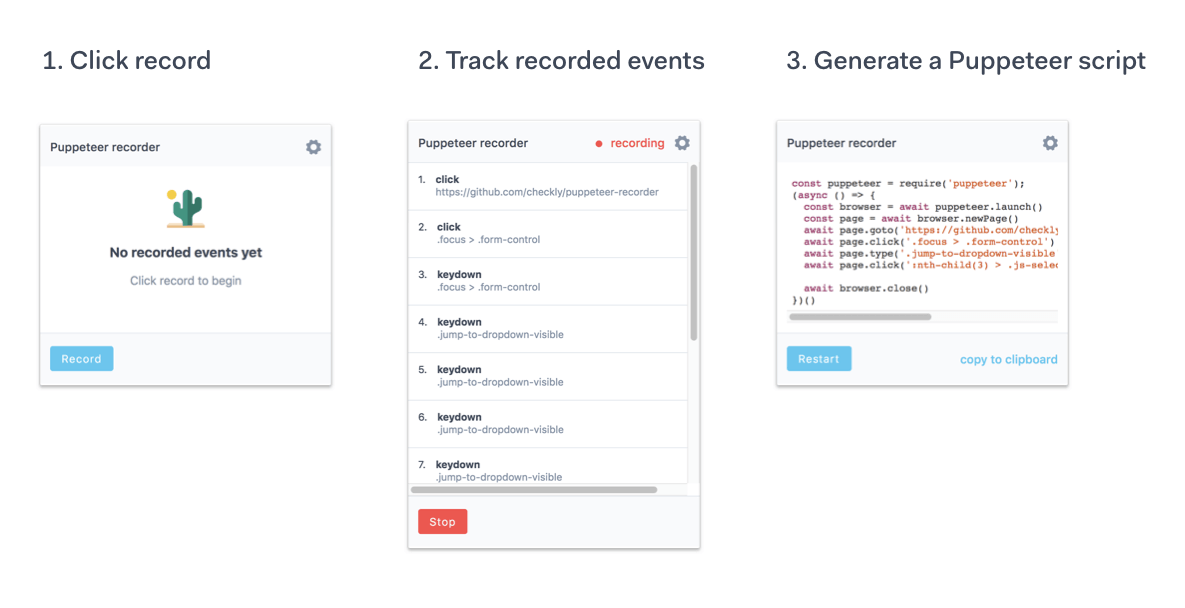每天推薦一個 GitHub 優質開源項目和一篇精選英文科技或編程文章原文,歡迎關注開源日報。交流QQ群:202790710;微博:https://weibo.com/openingsource;電報群 https://t.me/OpeningSourceOrg

今日推薦開源項目:《瀏覽器操作錄製 Puppeteer Recorder》傳送門:GitHub鏈接
推薦理由:顧名思義,這個 Chrome 上的 Recorder 能幫你錄製你在瀏覽器上的操作,然後生成一個腳本。雖然這聽起來很像按鍵精靈什麼的,但是興許你不僅可以把它用來重複操作,還能在調試的時候幫上忙,雖然現在能夠記錄的元素點擊事件並不算多,但是以後還會擴展,可以期待一下。

今日推薦英文原文:《Functional Programming Basics》作者:Robert C. Martin (Uncle Bob)
原文鏈接:https://pragprog.com/magazines/2013-01/functional-programming-basics
推薦理由:介紹函數式編程,興許有些人已經聽說過這玩意了,在這裡你可以看到與平常的面向對象的語言截然不同的代碼和操作方式
Functional Programming Basics
Confused about functional programming? 「Uncle Bob」 Martin strips the paradigm down to its essentials, and explains why you can and must understand functional programming now.
By now you』ve almost certainly heard of functional programming. I mean, how could you miss it? Everybody』s talking about it. There are all these new functional languages coming out like Scala, F#, and Clojure. People are talking about older languages too, like Erlang, Haskell, ML, and others.
So what』s this all about? Why is functional programming The Next Big Thing (tm)? And what in blazes is it?
First, it』s almost certainly true that functional programming is the next big thing. There are good solid reasons for this that we』ll explore later in this article. But in order to understand those reasons, we need to know what functional programming is.
I』m going to upset a lot of people with this next statement because I』m going to resort to extreme minimalism. I』m going to reduce functional programming down to its simplest core; and this isn』t really fair because the topic is rich and expressive and full of wonderful concepts. You』ll see hints of some of them here. But for now, I』ll simply define functional programming this way:
Functional programming is programming without assignment statements.
Oh no! Now I』ve gone and done it. The functional programmers out there are gathering their pitchforks and torches. They want my head for uttering such minimalist blasphemy. Meanwhile all the folks who hoped to learn what functional programming really is are about to stop reading because the above statement is so blatantly absurd. I mean: how in the world can you program without assignment?
The best way to explain that is to show an example. Let』s look at a very simple program in Java: the squares of integers.
public class Squint {
public static void main(String args[]) {
for (int i=1; i<=25; i++)
System.out.println(i*i);
}
}
Who hasn』t written that program, or some simple variant of it? I must have written it many hundreds of times. It』s often the second program I write in a new language, and the second or third program I teach new programmers to write. Everybody knows the good old squares of integers!
But let』s look at it closely. It』s just a simple loop with variable named i that counts up from 1 to 25. Each loop through the program causes the variable i to take on a new value. This is assignment. A new value is being assigned to the variable i every pass through the loop. If you could somehow peer into the memory of the computer and stare at the memory location that held the value of i, you would see the value held by that memory change from one iteration of the loop to the next.
If the previous paragraph seemed to have belabored an obvious point, let me point out that whole papers have been written on this topic. The concepts of identity, value, and state may seem intuitive to us, but they are actually a very rich topic in and of themselves. But I digress.
Let』s look at a functional program for the squares of integers. We』ll use the language Clojure for this, though the concepts we』re going to explore work the same in any functional language.
(take 25 (squares-of (integers)))
Yes, you are reading that correctly; and yes, that is an actual program that produces actual results. If you must see the results they are:
(1 4 9 16 25 36 49 64 ... 576 625)
There are three words in that program: take, squares-of, and integers. Each of those words refers to a function. The left parens in front of those words simply mean: call the following function and treat everything up to the closing right paren as its arguments.
The take function takes two arguments, an integer n, and a list l. It returns the first n items of l. The squares-of function takes a list of integers as its argument and returns a list of the squares of those integers. The integers function returns a list of integers in sequential order, starting at 1.
That』s it. The program simply takes the first 25 elements of a list of the squares of sequential integers starting at 1.
Read that sentence again; because I did something important there. I took the three separate definitions of the functions that I gave you in the preceding paragraph and combined them into a single sentence. That』s called: (are you ready for the buzzword?) Referential Transparency. [cue: Fanfare, glitter, ticker tape, cheering crowds]
Referential Transparency simply means that, in any given sentence, you can replace the words in that sentence with their definitions, and not change the meaning of the sentence. Or, more importantly for our purposes, it means that you can replace any function call with the value it returns. Let』s see this in action.
The function call (integers) returns (1 2 3 4 5 6 ...). OK, I know you』ve got questions about this, right? I mean, how big is this list? The real answer is that the list is only as big as I need it to be; but let』s not think about that just now. For the moment just accept that (integers) returns (1 2 3 4 5 6 ...); because it does!
Now, in our program, we can replace the function call (integers) with its value. So the program simply becomes:
(take 25 (squares-of (1 2 3 4 5 6 ...)))
Yes, I did that with copy and paste; and that』s also an important point. Referential Transparency is the same as copying the value of a function call and pasting it right on top of that function call.
Now, let』s do the next step. The function call (squares-of (1 2 3 4 5 6 ...)) simply returns a list of the squares of the numbers in its argument list. So it returns (1 4 9 16 25 36 49 64 ...). If we replace this function call with its value, our program simply becomes:
(take 25 (1 4 9 16 25 36 49 64 ...))
And, of course, the value of that function call is simply:
(1 4 9 16 25 36 49 64 ... 576 625)
Now let』s look at our program again:
(take 25 (squares-of (integers)))
Notice that it has no variables. Indeed, it has nothing more than three functions and one constant. Try writing the squares of integers in Java without using a variable. Oh, there』s probably a way to do it, but it certainly isn』t natural, and it wouldn』t read as nicely as my program above.
More importantly, if you could peer into the computer』s memory and look at the memory locations used by my program, you』d find that those locations would be initialized as the program first used them, but then they would retain their values, unchanged, throughout the rest of the execution of the program. In other words, no new values would be assigned to those locations.
Indeed, this is a necessary condition for Referential Transparency, which depends on the fact that every time you invoke a particular function call, you will get the same result. The fact that computer memory for my program does not change while my program is executing means that the call (f 1) will always return the same value no matter how many times it is called. And that means I can replace (f 1), wherever it appears, with its value.
Or to say this another way: Referential Transparency means that no function can have a side effect. And, of course, that means that no variable, once initialized, can ever change its value, since assignment is the quintessential side effect.
So why is this important? What』s so great about Referential Transparency? Given that it is possible to write programs without assignment, why is it important?
You are almost certainly reading this on the screen of your computer. Or if not, you have a computer nearby. How many cores does it have?
I』m typing this article on a MacBook Pro with 4 real cores. (They say it has 8, but I don』t count all that 「hyperthreading」 nonsense. It has four.) My previous laptop had two cores. And the one before that had just one. The only conclusion I can draw is that my next laptop will truly have eight cores; and the one after that will likely have 16.
The poor hardware engineers, who have carried us on their backs for the last four decades, have finally hit the speed of light limit. Computer clocks simply aren』t going to get much faster. After doubling every 18 months for longer than most programmers (except me) have lived, the runaway growth in computer speed has slammed to a halt, never to rise again.
So those hardware engineers, in an effort to give us more and more cycles per second, have resorted to adding more processors into our chips, and there seems no end to how many processors that will lead to as the years march onwards.
So let me ask you this, O skilled and competent programmer: How are you going to take advantage of every computer cycle available to you when your computer has 4096 cores in it? How will you marshal your function executions when they must run within 16384 processors all contending for the same memory buss? How will you build responsive and flexible websites when your models, views, and controllers must share 65536 processors?
Honestly, we programmers can barely get two Java threads to cooperate. And threads are baby-food compared to the meat and potatoes of real processors fighting over the buss. For over half a century programmers have made the observation that the processes running in a computer are concurrent, not simultaneous.
Well, boys and girls, welcome to the wonderful world of simultaneity! Now, how are you going to deal with it?
And the answer to that is, simply, 「Abandon all assignment, ye who enter here.」
Clearly, if the value of a memory location, once initialized, does not change during the course of a program execution, then there』s nothing for the 131072 processors to compete over. You don』t need semaphores if you don』t have side effects! You can』t have concurrent update (pardon me: Simultaneous Update) problems if you don』t update!
So that』s the big deal about functional languages; and it is one big fricking deal. There is a freight train barreling down the tracks towards us, with multi-core emblazoned on it; and you』d better be ready by the time it gets here.
Robert Martin (Uncle Bob) (@unclebobmartin) has been a programmer since 1970. He is the Master Craftsman at 8th Light inc, an acclaimed speaker at conferences worldwide, and the author of many books, including: The Clean Coder, Clean Code, Agile Software Development: Principles, Patterns, and Practices, and UML for Java Programmers. He is a prolific writer and has published hundreds of articles, papers, and blogs. He served as the Editor-in-chief of the C++ Report, and as the first chairman of the Agile Alliance.
A somewhat different version of this article, as well as much more about functional programming, can be found at the author』s blog. You can send him your feedback on this article or discuss the article in the magazine forum.
每天推薦一個 GitHub 優質開源項目和一篇精選英文科技或編程文章原文,歡迎關注開源日報。交流QQ群:202790710;微博:https://weibo.com/openingsource;電報群 https://t.me/OpeningSourceOrg

這些年都很關注面向對象編程,今天的文章 Functional Programming 挺不錯的,有了一點新的體會